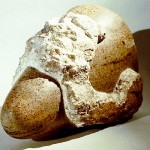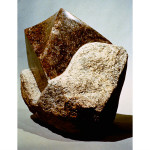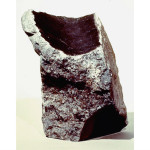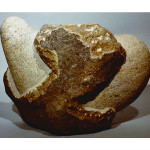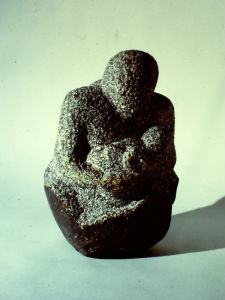Upon returning to Vermont I applied the same direct carving sensibility to the stones the glaciers had discarded in our fields. I carved directly, without preconceived notions, following natural patterns and responding to the inherent characteristics of each stone.
Have you ever noticed all those stonewalls that seem to meander through New England’s forests? They are actually the discards of glaciers and farmers. Thousands of years ago massive glaciers sheared off rock outcroppings and picked up massive stones as they rumbled south. Later, as the glaciers retreated, these rocks were deposited throughout the landscape buried under the glacier’s sediment. Forests grew out of this sediment. When the farmers began to clear the land for pastures and plantings they found these new fields grew stones, as well, if not better than, the crops they planted. Every spring they collected the stones the winter’s frost heaves pushed to the surface and they deposited them on the edges of their property. In time the forests took back the fields that lay fallow, but the stonewalls remained.
From afar those stones all look alike, similar in scale and color. But as you look closer the stones become more and more distinct. You start to notice that some stones are flatter and are marked by horizontal layering. Other stones are rounded, seemingly softer, their edges worn away as they tumbled about in the glacier. Yet others, while showing the wear of the journey, still possess a sharp edge or a protrusion that withstood the glacier’s abrasive processes. These are the stones that caught my eye even as a boy growing up in Vermont.
After my two years of volunteer service in Alaska, I returned to Vermont and enrolled in summer art classes. It was there in the basement of Williams Hall I happened upon the stone carving studio, complete with a pneumatic generator, pneumatic carving tools, and carving stands galore. The studio was empty that summer, and, after Paul Aschenbach showed me how to turn the generator on and how to handle the pneumatic tools, I moved in. I had total freedom and a place to experiment with the direct carving processes my Yupik students had taught me. What a gift.
While I wasn’t sure what I was going to do, I established some loose parameters to follow.
- I would carve directly without preconceived notions. I would just follow the natural patterns in the stone.
- All the stones were to come from the same old rock pile in a field near my home in Charlotte, Vermont. (In big fields, some farmers deposited the fieldstones in piles in the center, and not just as walls on the edges.)
- The rocks all had to be about as heavy as I could lift. (A rule I regret now every time we move.)
- I looked for stones that had “character” — those protrusions and angles that had defied the glacier.
I set up a half dozen rocks on carving stands and half dozen on the floor. In the beginning there was a lot of walking around and just looking at the stones from different angles. After this initial introduction, I started to carve by following a crack or discoloration. If after digging in I lost my way, I would simply move on to another stone with the understanding that I would return. At times I bounced back and forth between stones. My focus was on remaining open to what the stone offered. Some stones were hard enough to hold an edge or take a polish. Other stones with a grittier composition refused to take a polish, showing better with a textured surface. Other times, after digging in, a natural fault would give way and the stone would break into unusable pieces. On those rare occasions my head would drop in despair, but invariably Paul would happen by and say “Don’t start counting your carvings until you get to a hundred.”
In time, basic forms grew out of each rock. I liked the way the finished stone looked next to the raw stone so I carved with that juxtaposition in mind. I also liked the way the shapes evoked basic primordial gestures—thrusting, twisting, and contorting—like the actions that brought them to this point. And most of all, I liked the surprises of color and pattern that were only revealed when the final surface treatments were applied.
While these carvings reflected varying success as sculptures, this experience established a sensibility that would guide my work moving forward. I learned to
- work with materials at hand
- tap into the power of collaboration and dialogue,
- follow my intuition and be open and responsive to opportunity,
- pursue the wonder of ah-ha moments and natural surprise.
Stone carving is not hard, but stones are. It can be a time-consuming and physically demanding process. Therefore, stone carving does not lend itself to general art instruction. You won’t even find stone carving offered in most art schools. Some teachers have tried to get around the issues by having students carve large salt blocks or soap. While this may allow students to experience the subtractive sculpting process, the homogenous make-up of these materials makes them a lifeless medium. But, these hurdles are not a reason to exclude stone carving from the arts curriculum. Slide reviews of stone carvings can reveal the expressive potential of stonework. Here is one way to get there.
Using Internet images, create a slide show of master carvers. Show 4-6 characteristic works of a half dozen stone carvers. Here are some celebrated carvers who work with different stones and imagery; Constantin Brancusi, Jean Arp, Isamu Noguchi, Henry Moore, Jesus Moroles, and Nobuo Sekine. This site provides links to other contemporary stone carvers
The idea is to get a visceral response from the students first, so keep the descriptions to a minimum. Simply state the artists name and possibly the title of the sculpture. Have the students rank the artists according to preference.
Tally the results of the class poll. If there is a consensus around one sculptor explore that sculptor more in depth, identifying pivotal works and characteristic treatments or techniques. If multiple artists are preferred, divide the class by their preferences and have them select 2-3 works by that artist and explain why they are attracted to that artist. A few general questions to consider:
- What are the qualities of the stone the artist is tapping into?
- Could this sculpture be physically rendered in another medium—bronze, wood, plaster, glass, paper, or clay? (Scale, heft, and durability can be important factors in choosing stone.)
- If this sculpture were rendered in another medium would there be an aesthetic difference to the piece? (Brancusi and Moore both have similar forms rendered in marble and bronze. How is the aesthetic feel different with these other materials?)
- What kind of stone is the artist using? (Have student begin to recognize that different types of stone have different physical qualities.)
Remember that the idea here is to have students give voice to the values that guide their own aesthetic and to engage students in a discussion about the expressive potential of stone carving.

